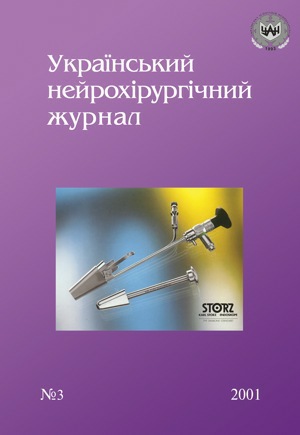Clinical and anatomical substantiation in predicting vast hemorrhage prior to meningioma surgery
Keywords:
forecasting, prevention, greater blood loss, supratentorial tumorsAbstract
To evaluate the risk of a considerable intraoperative blood loss (і1000 ml) in supratentorial meningioma patients, 140 cases have been analysed. In 60 the hemorrhage exceeded 1000 ml and was less in 80. The analysis has also revealed the major prognostically unfavourable factors increasing the risk of a large blood loss. These were: hypertonic disease or systolic arterial pressure elevation up to above 140 mm Hg during surgery; sizable tumor (> 5 cm in dia.); tumor location in the falciform process; partial tumor removal; excessive hemorrhagic diathesis.
With regard for the above factors it became possible to predict vast hemorrhages and take adequate preventive measures, thereby lowering the incidence of big blood losses by 8%.
References
Ермольев А.И. Прогнозирование и профилактика послеоперационных осложнений при опухолях спинного мозга: Автореф. дис. … канд. мед. наук. — Киев, 1999. — 18 с.
Чепкий Л.П., Ермольев А.И., Слинько Е.И., Пасько С.А. Прогнозирование кровотечений при хирургическом лечении опухолей спинного мозга// Укр. нейрохірургічний журнал. — 2000. — № 2. — С. 108—110.
Downloads
How to Cite
Issue
Section
License
Copyright (c) 2001 Leonard Chepkiy, S. Pasko, Aleksandr Lazun, L. Petrenko

This work is licensed under a Creative Commons Attribution 4.0 International License.
Ukrainian Neurosurgical Journal abides by the CREATIVE COMMONS copyright rights and permissions for open access journals.
Authors, who are published in this Journal, agree to the following conditions:
1. The authors reserve the right to authorship of the work and pass the first publication right of this work to the Journal under the terms of Creative Commons Attribution License, which allows others to freely distribute the published research with the obligatory reference to the authors of the original work and the first publication of the work in this Journal.
2. The authors have the right to conclude separate supplement agreements that relate to non-exclusive work distribution in the form of which it has been published by the Journal (for example, to upload the work to the online storage of the Journal or publish it as part of a monograph), provided that the reference to the first publication of the work in this Journal is included.









